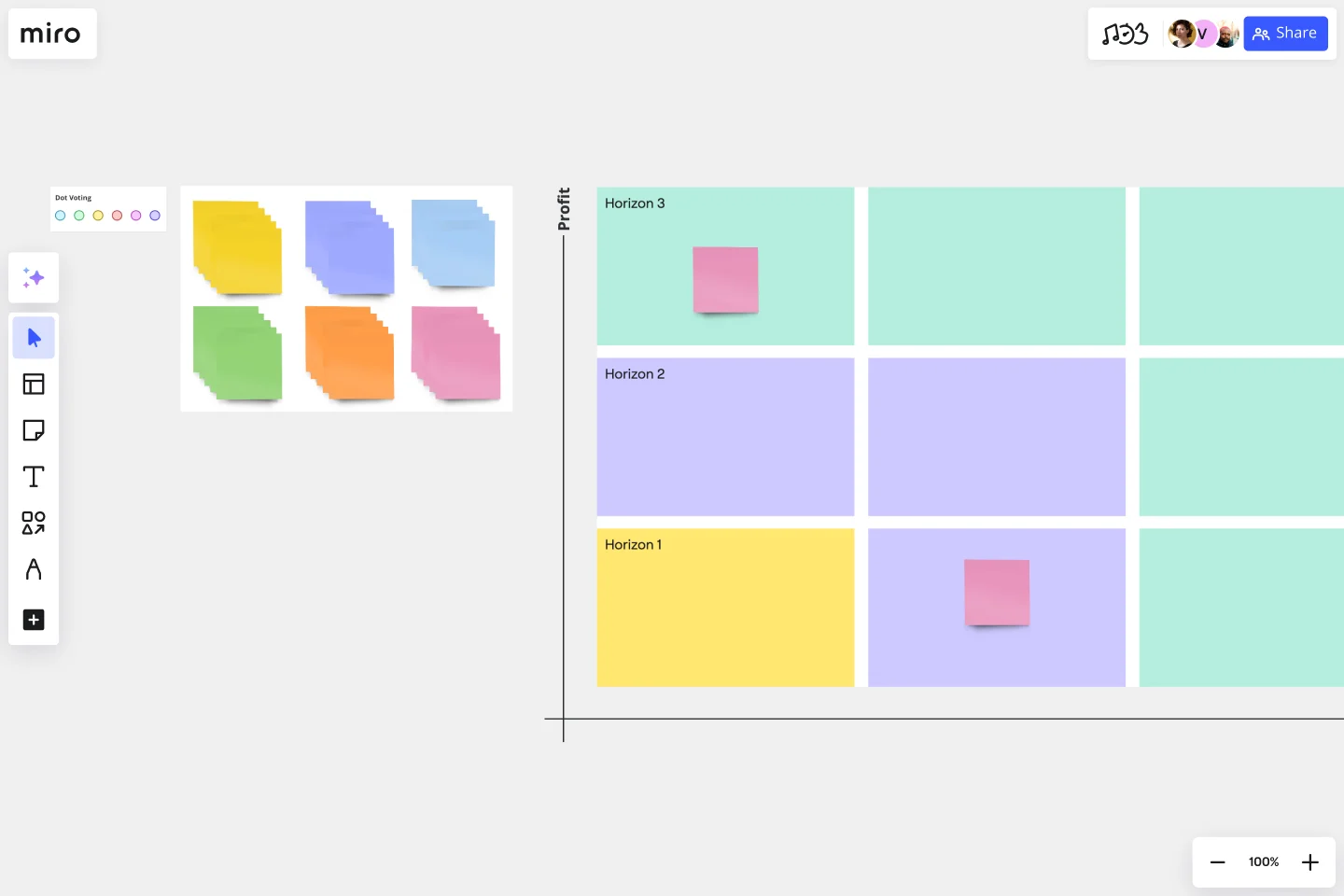3 Horizons of Growth Template
Concurrently manage current and future opportunities for growth.
About the 3 Horizons of Growth template
What is the 3 Horizons of Growth model?
As companies grow, it can be difficult to keep innovating at the same pace. Innovation is often discarded in favor of inertia. To keep up their momentum, organizations have to balance their existing business with potential growth opportunities. That’s where the 3 Horizons framework comes in.
First introduced in The Alchemy of Growth, the 3 Horizons of Growth model helps companies assess potential growth opportunities while finding ways to maintain existing business. C-suite leaders use the 3 Horizons model as a blueprint for investing in current products and services while looking to the future. But its use is not confined to the C-suite. Teams across the organization can make use of the 3 Horizons model to ensure their projects map to the organization’s goals.
What are the 3 Horizons?
The 3 Horizons represent current opportunities, future opportunities that require substantial investment, and ideas for future opportunities that can be used as experiments, pilots, or minority stakes in new businesses.
How do you use the 3 Horizons of Growth template?
Use the 3 Horizons of Growth template when you want to strategically think about your business currently and in the future. The x-axis represents time, but keep in mind that it’s not an indication of what you should be thinking about now vs. later. You should be thinking about all three horizons at the same time. You will always want to cycle between where your business is strong now, which opportunities you believe will be successful in the future, and which opportunities you’d like to explore further.
What are the benefits of the Horizons of Growth model?
Benefit 1 - Take stock of current opportunities. To start, the Horizons of Growth model requires you to make a note of all current opportunities. This exercise helps frame the rest of the model and ensure you’re aligned with your team.
Benefit 2 - Identify future opportunities for investment. The Horizons model empowers you to pinpoint opportunities to maximize cash flow. Use the model to brainstorm with your team and come up with ideas for quick wins.
Benefit 3 - Experiment and iterate. Many C-suite execs use the Horizons of Growth model to find potential areas for experimentation. Those might include research projects, pilot programs, or minority stakes in new business.
When to use the 3 Horizons of Growth model
1. To foster a culture of innovation
2. To create a framework necessary for achieving long-term initiatives
3. To identify opportunities for new business
4. To enhance business analysis and focus on potential challenges
5. To prepare a developmental plan
Get started with this template right now.
Timeline Design
Works best for:
Timeline, Planning
The Timeline Design template is perfect for creating visually engaging timelines. It helps you showcase project milestones, deadlines, and important events in a clear and attractive format. Ideal for presentations and reports, this template ensures your timeline is both informative and visually appealing.
How Now Wow Matrix Template
Works best for:
Ideation, Product Management, Prioritization
There are no bad ideas in a brainstorm — but some are more original and easier to implement. The How Now Wow matrix is a tool that helps you identify and organize those great ideas, as well as reinvigorates your team to think creatively and take risks (a taller order as you scale). Grab this template to create your own matrix, then rank the ideas you generated in a brainstorm as “How” (difficult to implement), “Now” (easy to implement), or “Wow” (both original and easy to implement).
Likert Scale Template
Works best for:
Desk Research, Decision Making, Product Management
It’s not always easy to measure complex, highly subjective data — like how people feel about your product, service, or experience. But the Likert scale is designed to help you do it. This scale allows your existing or potential customers to respond to a statement or question with a range of phrases or numbers (e.g., from “strongly agree” to “neutral,” to “strongly disagree,” or from 1 to 5). The goal is to ask your customer some specific questions to turn into easy-to-interpret actionable user insights.
AARRR Template
Works best for:
Marketing, Strategic Planning, Project Planning
Sometimes called “Pirate Metrics” because of the name (go ahead, say it, it’s fun), AARRR is a valuable approach for startups to consider. That’s because AARRR stands for Acquisition, Activation, Retention, Referral, and Revenue—five key types of user behavior that are highly measurable and drive growth. Ask and answer the right questions around each of these five factors, and you’ll be able to establish clear goals and identify the best steps to help reach them.
Customer Problem Statement Template
Works best for:
Ideation, Design Thinking, Product Management
Put yourself in the shoes of your consumers with a customer problem statement. Figure out their problems and how your product or service can solve those problems and make their lives easier. As a bonus, you’ll better understand your customers throughout the process.
Blue Ocean 4 Actions Framework Template
Works best for:
Leadership, Decision Making, Strategic Planning
For entrepreneurs, so much comes down to new users—how to attract them, impress them, and convert them to loyal customers. This template, designed by the authors of Blue Ocean Strategy: How to Create Uncontested Market Space and Make the Competition Irrelevant, will help you maximize value for you and your customers alike. Using the template’s four steps (divided into easy columns), you’ll easily evaluate your products in more innovative ways and make sure money is being spent in areas that really matter.
